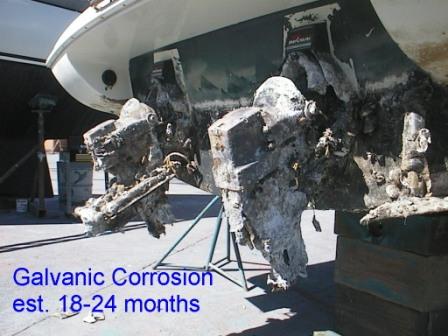Galvanic corrosion. What is it? Simply put, it’s when two dissimilar metals are together in a corrosive liquid – such as saltwater – and they create a charge which severely corrodes one of the two metals.
Some metals are highly corrosive (anodes) and some aren’t (cathodes). Anodes put together with cathodes are “dissimilar metals”. The more dissimilar the metals are, the higher the level of corrosion.
Here is a chart to illustrate:
For the sake of simplicity, let’s take the two extremes: magnesium and gold (NOTE: magnesium is never used in saltwater!). If you put both of those together in water, in more-or-less equal parts, the magnesium will begin to corrode until it eventually disappears. A more practical application is if you have, let’s say, a stainless steel propeller and an aluminum outdrive casing. You can guess which part of the boat is in danger!
At first it seems that the solution is obvious: just don’t use anode materials in your boat. And if you must, then don’t put them together with a cathode. Easy, right? Unfortunately, it’s just not that simple.
The reason is that the damaging current that occurs between two dissimilar metals can technically be transferred from boat to boat via the shore power cords when the boats are docked.
I am borrowing this particular illustration from BoatUS.com to explain how this works:
Basically, what happens here is that the grounding wire and the seawater together create the damaging current, and if your boat has any type of active metal whereas your neighbor doesn’t, then your boat’s elements will suffer from corrosion faster. This is the case even if you have fairly cathodic metals in your boat. If someone else has MORE noble materials (another term for cathodic), then your boat’s elements are in danger.
So, how does a boater overcome this problem? The key is taking proactive steps to PROTECT your active metals. There are a few main components:
1. Sacrificial Anodes: These are metal parts constructed of an active (anode) metal such as magnesium or zinc which are then bolted on to various parts of your boat. They are installed with the purpose of absorbing the damage of the electrolysis and corrode faster than the more essential parts of your boat- thus the name, sacrificial anode. You know these parts are going to corrode, but that the other, more important elements of the outdrive will be protected.
2. Electronic corrosion inhibitors: These are special devices that compliment the Sacrificial Anodes. They create a protective current around the outdrive and propellers which further inhibit corrosion. Depending on your engine manufacturer, there will be a brand-specific unit- for instance, Mercathode for Mercury, The QL Active Corrosion Protection System for Volvo.
3. Galvanic Isolators: These devices are connected in series into the boat’s green safety grounding lead and block low-voltage DC currents coming on board your boat.
4. Most Importantly: The single most important element of this whole equation is vigilant monitoring of the sacrificial anodes on your boat. When those start to go- it’s time to replace them and to check all other protective methods as well. Your service provider will be able to spot these signs of corrosion, but you may also want to check them yourself on a regular basis.
Also worth noting is the fact that this corrosion occurs at a much faster rate in warm climates, and that proper use of paint on the boat’s hull and around the underwater metals makes a big difference, too.
The subject of galvanic corrosion is important because it is a huge problem that can be easily addressed with the proper care. Here in South Florida, the warm weather and high volume of moored boats at any given time can cause a lot of trouble FAST. And even if you live somewhere that is mercifully cooler than it is here, if you don’t pay attention to your anodes your boat can end up looking like this:

This photo illustrates the severely damaging effects of galvanic corrosion if it is not properly tended to. Courtesy of QualityMarineServices.com
We hope that you will have better luck than this fellow boater. Your luck will be improved by conducting checks on a regular basis!
If you would like a consultation on your boat’s corrosion inhibiting systems and make sure they are all up to standard, click here. If you would like to speak directly with Rick, our General Manager, regarding having your boat serviced you can call 954-894-9895. We carry most I/O and shaft zincs, and if we don’t have what you are looking for we can order it – it’s usually here the same day. As a token of our appreciation, mention Promo Code ZINCS when you call to receive 15% OFF your next purchase of zincs.
Happy Boating!

